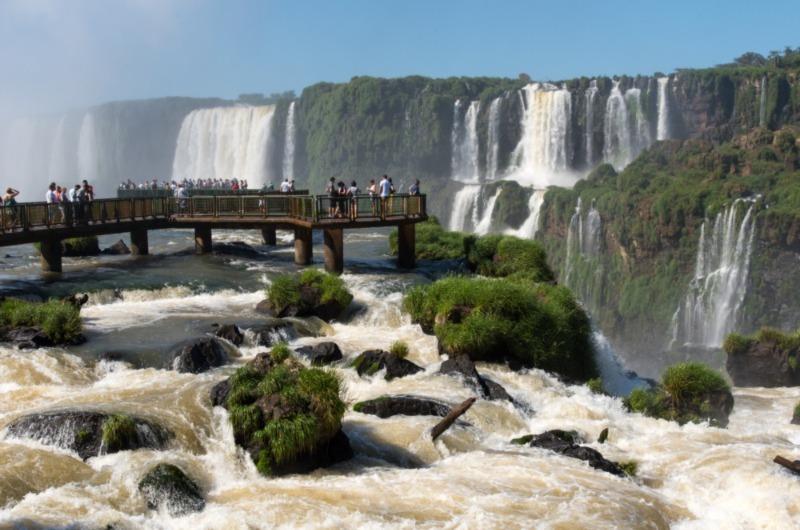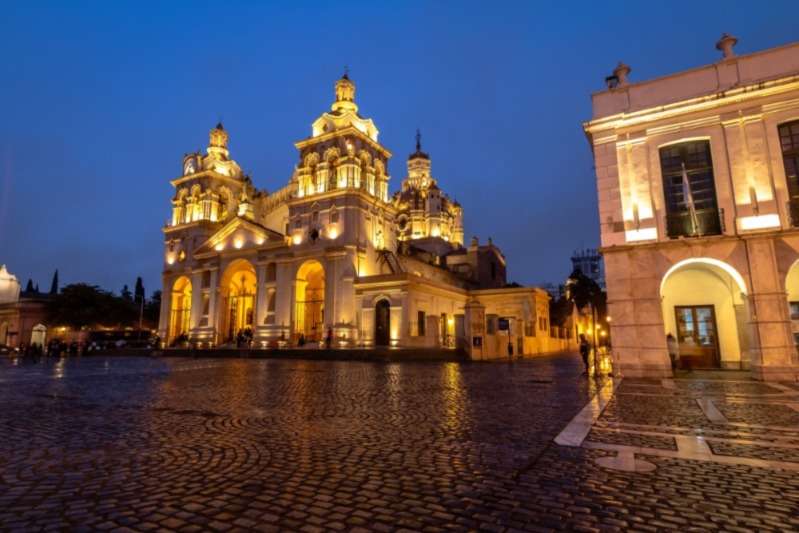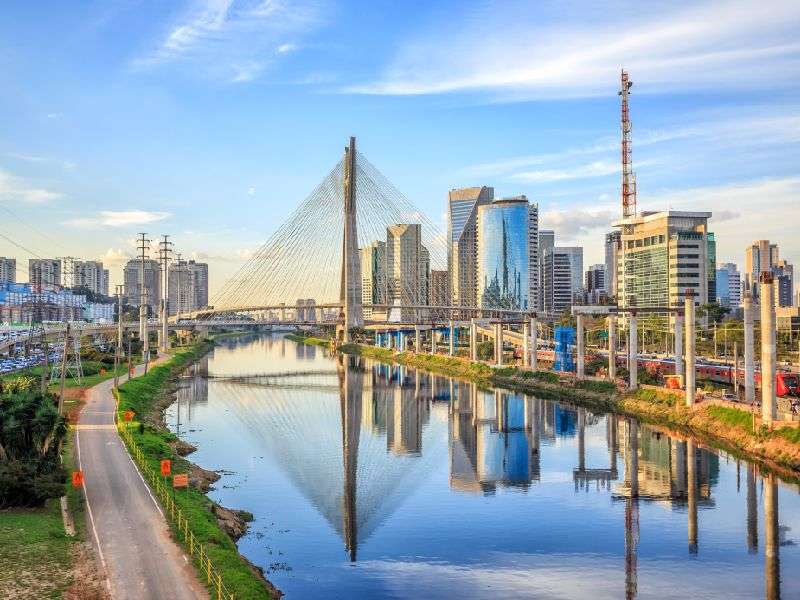
Iguaçu National Park
Iguacu National Park is the protected area for Iguassu Falls on the Brazil side of the falls and is situated on the border of Argentina and Brazil. The national park spans 660 square kilometers of land (1,700 sq km).
Less than 1% of the Iguacu National Park protected area is made up of the route that runs alongside the canyon and falls, lookouts, and the nearby rainforest of Iguassu Falls. Visitors to Iguassu Falls only explore this region. The world's largest waterfall system, Iguassu Falls is protected by Iguazu National Park on the Argentinean side. Over the course of the 1.7 miles (2.7 km) of falls, there are 275 distinct drops.
The Devil's Throat, which is 269 feet (82 meters) tall and the beginning of the shared border canyon, is where the falls' highest point is located. The falls range in height from Devil's Throat to the lowest falls, which are 197 feet tall (60 m). The giant otter and the giant anteater, both of which are endangered, can be found in Iguacu National Park and the vicinity of Iguassu Falls. Other wildlife sights that are hoped for include seeing jaguars, jaguarundis, ocelots, tapirs, and toucans. The coati and a profusion of butterflies are fortunately visible to most tourists.
Only from the Brazilian side, guests can take a helicopter trip to experience one of the most breathtaking aerial views of the falls. In addition, a rappelling line descends directly from an extended medal platform. By doing so, you can dangle in the air and look directly over the canyon at the falls' Argentina side.
Taking the patched walk along the canyon wall on the Brazilian side, which offers thorough views of the falls on the Argentine side, is the easiest way to witness the falls. Along the route, there are lookouts and a metal boardwalk that spans the river to provide close-up, wet views of the falls.
History of the Park
Because it contains a significant portion of the Iguazu River (also known as Rio Iguaçu in Portuguese), the Iguaçu National Park earned its name. The Iguaçu Falls are located in a section of the river that is around 50 square kilometers (19 square miles) long.
It is the most significant park in the Prata Basin and the first park in Brazil to get a management plan because it protects a large genetic asset of animal and plant species. As Rebouças anticipated, the park's primary objective is the preservation of the ecologically significant and aesthetically pleasing natural ecosystems, enabling scientific research, the growth of environmental education and interpretation activities, leisure in natural settings, and ecological tourism.
The Iguaçu National Park is both breathtaking and innovative. In his book "Provinces of Paraná, Railways to Mato Grosso and Bolivia," engineer André Rebouças used these words to launch the first preservation effort for the Iguaçu Falls in 1876, when Yellowstone National Park, the world's first national park, was only four years old.
Iguaçu National Park, one of South America's largest forest preservation zones, was designated as a Natural Heritage of Humanity on November 17, 1986, during the UNESCO convention held in Paris.
Due to the operation of dams on the upper Iguazu River, the natural beauty of the Iguaz waterfalls is being negatively harmed by manmade variations in river levels. There are still worries about the potential adverse impacts on the ecosystem of abnormal changes in water levels caused by the recently built Baixo Iguaçu dam near the limits of Brazil's Iguazu National Park and Iguaçu National Park.
Iguazu National Park's management and protection are largely successful within its bounds, especially in light of the high rate of visitor traffic and the growing influence of research and monitoring on management choices. Studies on the site's biodiversity generally show that it is being preserved.
Activities to Enjoy
Safari by Jetboat
The most enjoyable experience you'll ever have in rapid water is the jetboat safari. You'll arrive at a calm area of the river where you board a powerful twin-engine jet boat that will travel four miles down the Iguazu River and through the various tiers of the falls, all promising exceptional views of the gorgeous scenery. This comes after a short hike through the rainforest and a buggy ride through the jungle. With this exhilarating journey, you are taken directly into Devil's Throat, where the boat will speed over torrents and cascades, shoot the rapids, and carry you down the depths of the deafening falls.
You'll emerge from your unique experience totally soaked with a great grin on your face knowing that you just made it below one of the biggest waterfalls in the world.
Explore Iguaz National Park
Iguazu National Park is actually made up of two separate parks, one on the Argentinian side and one on the Brazilian side of the border. More than 2,000 different types of vascular plants can be found there, along with animals including tapirs, anteaters, howler monkeys, ocelots, jaguars, and caymans. The world's biggest single protected Paranaense subtropical rainforest is made up of Iguazu National Park, the adjacent World Heritage Site Iguacu National Park in Brazil, and nearby protected regions. This park, which lies on the Argentinean side of the Iguazu Falls, has a lot to offer and necessitates some walking.
Follow the four-mile roundtrip Macuco Trek, the most difficult trail of them all, through the jungle to Arrechea, the only waterfall where swimming is permitted. Capuchin monkeys may be present along the route.
Airborne Tour
You can only get this incredible bird's eye perspective of the falls by taking a helicopter trip over them. You can choose between a quick 10-minute ride and a longer 35-minute tour that also passes by Foz do Iguacu and the Itaipu Dam. Although the back seat of the helicopter can be perfect for those who love taking pictures, many people lust after the front seat since it offers unhindered vistas.
Visit Itaipu Dam (Brazil)
The Itaipu Dam, which formerly held the record for the biggest hydroelectric dam in the world, is now only second to China's infamous Three Gorges. A two-hour tour of the facility allows you to witness how the water from the Iguassu River is used to generate energy. This hydroelectric dam benefits Paraguay, Argentina, and Brazil together. The tour includes a viewing of a documentary that describes the history and significance of the dam, a journey to the spillway's front, and, eventually, a halt over the upper portion of the dam. Keep your hard hat on as you descend deep inside the power plant in an elevator and experience the heat produced by the rushing water.
After seeing the dam, taking the Itaipu Lake Sunset tour is a relaxing way to cap off your day. You'll sail on a catamaran to the lake's center to watch what, ideally, will be a spectacular sunset.
Visit Aripuca & Güira Oga
These two locations are in Puerto Iguazu, and you can visit them while taking a city tour with a bilingual guide who will provide some useful information.
For those who love the outdoors, the Aripuca theme park is a fantastic choice. This tourism destination aims to share the local culture and customs while raising awareness of the natural resources and encouraging environmental protection and promotion. The wood construction stands 17 meters high. This name derives from the Guaran culture, where a trap was used to catch small game.
On the other side, we have the Güira Oga Bird House, whose major goal is to prevent the extinction of various bird species and encourage the preservation of those species in their natural habitat. The ultimate objective is to reintroduce the species to their natural habitat.
Foz do Iguacu — Bird's Park
You can include this activity in your visit if you are taking in the Falls from the Brazilian side. Numerous bird species are housed in the Bird's Park, a globally renowned sanctuary and breeding ground for endangered species. Eagles, owls, parrots, toucans, butterflies, and reptiles like alligators and anacondas are a few of the species you might encounter. If you are traveling with children, the visit, which lasts around an hour or two, is highly advised.
Itaipu Dam
The American Association of Civil Engineering has named this hydroelectric dam one of the world's seven modern wonders. You may enjoy the view of this enormous building from the balcony. For those with an interest in engineering and construction, this tour is advised. Additionally, during the trip to the Brazilian side of the Falls, might be added.

Let's Tailor-Make Your Trip to Brazil Here!
Best Time to Visit
Iguaz Falls are best visited in the months of March, April, and May when rain is at a minimum and temperatures are more agreeable and mild. However, those who wish to avoid crowds may try to schedule a date outside of the weekends or Easter holidays. The Iguaz Falls has a humid subtropical climate resembling that of the jungle. While fall, winter, and spring feature moderate days, summers are extremely scorching. However, it is crucial to keep in mind that there may be cool days during the winter (average temperatures of 15°C), therefore it is advised to pack something warm. For people who are not adapted to heat and humidity, summer temperatures (from December to March) can be too much.
related tours

Highlights of Latin America Tour
9 Days / 8 Nights
From
$ 1944

Best of South American Tour
12 Days/11 nights
From
$ 3473

Salvador and Chapada Diamantina National Park
8 Days | 7 Nights
From
$ 835

São Paulo in three days
3 Days / 2 Nights
From
$ 215
